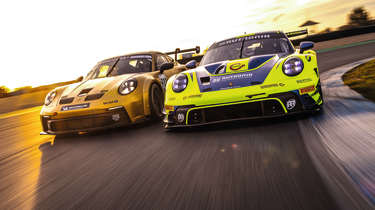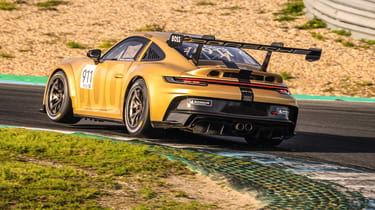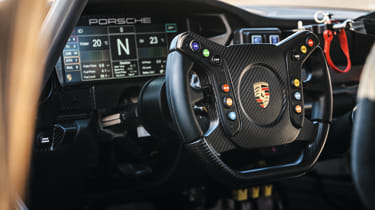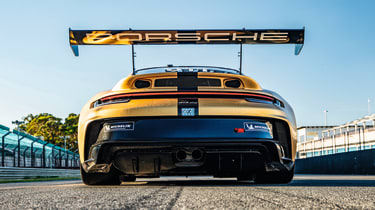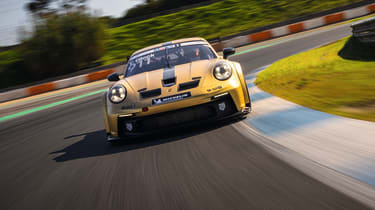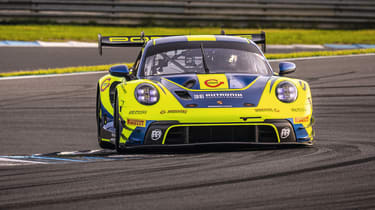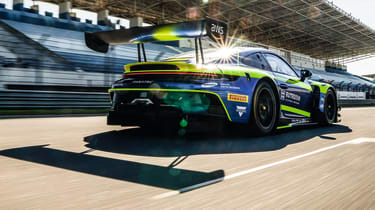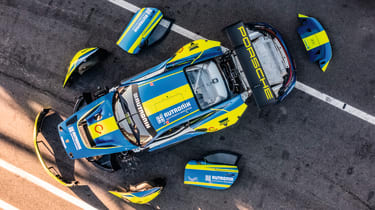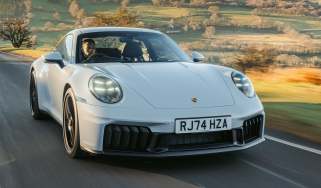Porsche 911 GT3 R & Porsche 911 GT3 Cup – driving Stuttgart's track-only racers back-to-back
What’s more exciting than a 911 GT3? A racing one. Or two of them. This year Porsche’s 911 GT3 R will tackle Le Mans, and its GT3 Cup car will race on six separate continents. We drive them both
There’s an atmosphere to Estoril. Not an electric, dramatic one, more a semi-sleepy, half-forgotten one. The hotel close to the circuit’s gates that in a previous life would have been heaving with patrons during Portuguese Grand Prix weekends is abandoned. The track within the gates, half an hour’s drive from Lisbon, is faded but still smart; packed with history without feeling like a museum piece. I really like it here. F1 last visited in 1996; MotoGP in 2012. But it’s still an active circuit, and a well-maintained one, used nowadays for various racing events, car launches and testing.
Today is a bit of a blend of all three. In the pitlane is a contingent of engineers from Porsche Motorsport and two different, equally immaculate, racing 911s. It’s a timely moment to test both of them: this year the new LMGT3 racing class replaces the more costly GTE category in the World Endurance Championship, meaning GT3-spec racing cars will now race at Le Mans, in the hands of private teams. Among them will be a pair of Porsche 911 GT3 Rs, just like the stunning blue/lime-green car here.
> Why the Porsche 911 GT3 RS (997.1) is one of the most significant cars of the last 25 years
The Porsche Supercup, meanwhile, has just celebrated its 30th birthday: the Formula 1 support race championship for identical race-spec 911s kicked off in 1993. The domestic Carrera Cup championships around the world, which use the same 911 GT3 Cup car, have been running for far longer, starting with the original Carrera Cup Germany series in the ’80s. On an average in-season weekend, at least five Carrera Cup championships are running around the world, with around 80 cars in action across multiple continents, including Europe, Asia, North and South America, Australia and the Middle East. One of the closest-fought is the Carrera Cup GB, supporting the British Touring Car Championship.
Porsche 911 GT3 Cup
Since 1990, more than 5000 – five thousand! – dedicated 911 Cup cars have been built, from the first 964-based cars through to today’s 992 generation. The gold car here is exactly the 5000th car built. Following racing action as the VIP guest car in the Supercup (the driver name stickers in the windows show that it was last raced by ex-F1 driver Timo Glock) it will shortly go on permanent display in the Porsche museum. But not before evo has had a stint behind its wheel.
‘It’s built on the same production line as 911 road cars at Zuffenhausen,’ explains the car’s project leader Jan Feldmann, who was involved in the 992 GT3 Cup car’s creation from ‘Minute One’ (although he stresses that many people at Porsche’s Flacht centre developed the car: ‘It has many fathers,’ he says). The 992 Cup will shortly begin its third season of racing following its introduction in 2022. Feldmann’s enthusiasm – and that of the rest of the Porsche motorsport team – for the Cup car is palpable. ‘A lot of my heart is lost in this car,’ he grins.
‘It’s different from engineering a more technologically complex car such as the GT3 R,’ he adds, nodding toward the wider, giganta-winged endurance racer. ‘The Cup car has to be built many, many times.’ At full capacity, Porsche is building five a day, he explains. ‘But that brings the cost down,’ he adds. In the UK, a Carrera Cup car costs around £180,000 – similar money to a 911 Turbo S road car. Before tax, that is; racing cars are invariably sold sans VAT, and 911 Cup car sales are prioritised for race teams over individuals.
Compared with the previous 991 Cup car, which had a reputation as a challenging machine to get the best from, Porsche has worked to make the 992 a more forgiving car on the limit, with a wider track and greater downforce. In response to customer demand, it’s also allowed for the car to be fitted with traction control as an option, in addition to ABS. The top Cup championships – including the Supercup – run with neither system. ‘If you learn to race with no TC and no ABS, you know how to drive a car,’ Feldmann says. ‘And if you are at the front in these cars, you are probably going to do well in your career.’ Since Carrera Cup alumni include a few overall Le Mans 24 Hours winners, such as Nick Tandy, he has a point.
One other noteworthy feature in response to customer feedback: it’s easier to install a passenger seat, for teams to give passenger rides to guests and sponsors. Something we’re about to get a taste of. The distant shriek of the gold car out on track turns to a nearby growl as it rumbles down the pitlane and hits its marks. Behind the wheel is Danish driver Bastian Buus, 2023 Supercup champion (the youngest champ yet, at 20 years old), who’s been warming the car up. Our first experience of it will be from the passenger seat.
It’s an eye-opening introduction – quite literally. Watching the GoPro footage back later, I see my eyes widen momentarily where I’m waiting to see where the braking point is for one of Estoril’s quicker corners, only to discover there isn’t one. Or not much of one at any rate. The Cup car’s limits – particularly in terms of entry speed – are far higher than I’d expected.
Time to find out for myself. Having squeezed through the roll-cage and into the driver’s seat, the sense of quality is impressive. This racing car feels better built and more smartly finished than some mass-production road cars I’ve sat in. Bodyshells used for Cup cars have one difference versus 911 road cars – they’re entirely painted inside as well as out, so if a team needs to remove any plates or panels, it always looks neatly uniform. ‘We had to teach the robots to reach further inside the car to do it,’ Feldmann says. This is definitely a German car.
There’s a wide range of adjustment for the cut-down steering wheel’s column – getting drivers of all heights comfortable in the car was another design goal for the 992-generation car – but once the safety net is clicked into place and the lightened door clicked shut, there’s the typical GT racing car sense of being buried low inside the shell. And the car feels big: the GT3 Cup uses the wider bodyshell from the 992 Turbo as part of its quest for greater stability. And stability is something this car has in spades, I’m about to discover.
A hiss of air as the car is released from its in-built pneumatic jacks and sets its slick tyres down on the ground. Click the right-hand paddle into gear (the Cup car uses a six-speed sequential dog-ring gearbox, running through a racing differential, a big weight saving over the road car transmission) and use the clutch pedal to pull away. Clutch take-up is light and smooth, not a switch like some racing cars. Any half-hearted application of the throttle in the lower gears is punished with a nodding-dog jerk through the driveline; better to bury the accelerator and let the car sit smoothly on its 60kph pit limiter. I’ve already braced my neck muscles when I release the limiter at the pitlane stripe, but my head still hits the restraint as the GT3 Cup catapults forward.
Its 4-litre, 503bhp engine is based on that of the standard GT3 road car rather than the RS model. The sound it makes is deliciously savage. Combined with the whine of the straight-cut gears, there’s an extra serrated edge to the six horizontal cylinders thrashing away behind you that isn’t there in the road car. This car also uses the shoutier Supercup exhausts, which take advantage of the relaxed noise regs at Grand Prix weekends. Earplugs are essential.
The way it stops is as exciting as the way it goes. You might need a little tweak of the wheel here and there to trim its line if you’re hitting the four-piston Brembos hard enough to trigger the ABS, but the car is remarkably stable. And feel and feedback through the pedal is fantastic. In fact that’s what defines the car – feel and feedback. You’re so in touch with what’s going on that the GT3 Cup’s limits feel very approachable.
On Porsche’s recommendation (or polite request, given the car’s provenance), we’re running with both TC and ABS on, but it’s only when you really lean on the throttle out of Estoril’s first-gear bus-stop chicane that you see blue lights winking on the dash, letting you know you’ve triggered the TC. Within a couple of laps you’re happy to leave your braking as late as you dare from 160mph or so for the 120-degree Turn One, knowing there’s an electronic ABS cushion to lean on should you need it. But the feel through the pedal is so precise that you rarely need to rouse the electronics. In the dry, at least.
For all the GT3 Cup’s stability and approachability, you’re really driving it; correcting the steering for weight transfer in all stages of the corner, choosing a line to suit the rear-biased weight distribution and finding time on (and off) the brakes. The driver makes the difference (suffice to say, I’m a good bit slower than Bastian). Above all, it’s fun. Not all racing cars are; they’re there to do a job. But, perhaps due to this car’s inherent shared DNA with the 911 road car, it’s as enjoyable as a pure sports car around Estoril. More so, in fact, because it’s a barely silenced, howling racing car that drives exactly the way it looks. Another design goal for the 992 Cup after the 991, incidentally; Porsche wanted it to look more like a racing car, after some customers commented that the 911 GT3 RS in their garage looked meaner than the race car parked alongside it. With its wider body and more prominent aero, the 992 Cup definitely looks like a junior GT3 racing car.
Porsche 911 GT3 R
Now for the senior one. The GT3 R isn’t built on the 911 production line, and although it incorporates elements of the road car’s structure, regs allow it to mutate the 911’s overall dimensions. It’s more than two metres wide, and the rear wing is so huge that to take a picture of the car on my phone, I need to take two, then three steps back to fit it all in. The 992 GT3 R made its debut last year and, compared with the previous 991 GT3 R, the engine has been enlarged to 4.2 litres. It’s still a naturally aspirated flat-six, and the whole thing is tilted forward by 5.5 degrees, making space for a longer diffuser. In GT3 racing, downforce is all-important.
As an aside, I have to confess it’s a little discombobulating to talk about two different cars called a Porsche 911 GT3, only one of which competes in a category called GT3 racing. So, as much to get it straight in my own head as to patronise anyone reading this, the GT3 Cup is named after the 911 GT3 road car (and shares some components with it). The GT3 R is a more bespoke, but still road-related, racing car built to GT3 regulations to be sold to customer teams and race against GT3 cars from other manufacturers. All manner of GT racing organisations around the world allow GT3 cars to enter, from the British GT Championship to the German DTM, to the Spa and Nürburgring 24 Hours to, from this year on, the WEC. (Appropriately/confusingly, the 911 GT3 road car was also originally named after an earlier iteration of the GT3 racing class.)
Given that GT3 racing is all about pro drivers teamed with amateurs, one of the goals for the 992-gen GT3 R was to possess easier handling at the limit, as well as look after its tyres better in long stints. To that end, weight distribution has moved forward a little, and both track and wheelbase have increased for a more stable footprint – similar goals to those set for the 992 Cup car.
Inside, while the digital screen behind the wheel is the same as the Cup’s, there are a good few other differences. The seat stays put while the pedal box slides to establish your driving position. In the centre of the dash is a rear-facing camera, to help spot lunging prototypes lapping the GT3 field in endurance races. Everything feels more substantial; more serious.
You pull away by clicking a clutch paddle: there are only two pedals, and the brake is neatly positioned to suit both left- or right-foot brakers more easily than the Cup car’s production-spec pedalbox. Exiting the pits is a smoother experience, and that extends to how the GT3 R drives across the board.
I thought the Cup car rode the kerbs well, but the GT3 R is like a limo. For what looks like a rock-hard racing car on the outside, there’s a reasonable amount of body roll. And for a car wearing such enormous slick tyres, it’s very communicative: as in the Cup, you feel exactly what’s going on. What’s more, you feel the downforce, even in the slow stuff. The speed you can roll into corners is absurd – and addictive.
As is the braking. I’m leaving my braking point for Turn One at the end of Estoril’s long pit straight later than in the Cup car, yet every time it could have been later still. The brakes don’t feel as nice as the Cup car’s: the pedal has a long travel, and there’s what feels like a momentary pause when you hit it hard (the merest fraction of a fraction of a second, but which feels like a long time at the end of a sixth-gear straight), perhaps while the ABS assesses the situation and distributes force accordingly. But my goodness does it get the car stopped.
It still feels like a 911 in terms of weight transfer; unlike with the 911 RSR that ran in the now-discontinued high-tech GTE class, Porsche doesn’t have the luxury of making this car mid-engined. But it’s intuitive, confidence-inspiring and, again, fun. I’d expected to enjoy the GT3 Cup more than the GT3 R – the Cup is more of a wrestling match, more of a car you drive in a traditional sense. But there’s something about the GT3 R. You can take lines you can’t take in the Cup. You can carry entry speed that seems impossible. As amazing as the Cup car is, this is five steps beyond.
I don’t want to stop driving it. But a longer test in a GT3 R is an unlikely dream. Motorsport insiders reckon one kilometre in a GT3 R costs about €45. Which means my five laps of Estoril set Porsche back about €940. But to put the ‘cheaper’ running costs of GT3 versus GTE in perspective, the 911 RSR’s gearbox alone cost €125,000.
As we leave Estoril’s paddock to its semi-slumber, both cars are circulating, the GT3 R’s slightly deeper, more resonant note offset by the zingier Supercup car’s soprano pipes. The GT3 R blew my mind but the GT3 Cup is the car that would equip a serious professional driver with the skills to extract the maximum from it.
It’s also left me with even greater respect for evo’s 2023 Car of the Year winner, the road-going 911 GT3 RS. Thanks to the magic of active aero, it can lap as quickly, or quicker in certain circumstances, than the GT3 Cup car can on slicks. Given that the Cup car has just recalibrated my understanding of entry speeds and stability (before the GT3 R shifted the goalposts once more), that achievement seems even more astounding than ever.
Specs
| Porsche 911 GT3 R | Porsche 911 GT3 Cup | |
| Engine | Flat-six, 4194cc | Flat-six, 3996cc |
| Power | 557bhp (est) @ 8000rpm (est) | 503bhp @ 8400rpm |
| Weight | 1250kg (approx, depending on BoP) | 1260kg (approx) |
| Torque | 400lb ft (est) @ 6000rpm (est) | 346lb ft @ 6150rpm |
| Power-to-weight | 453bhp/ton (approx) | 406bhp/ton (approx) |
| Price | £435,500+VAT | £177,900+VAT |
This story was first featured in evo issue 319.
